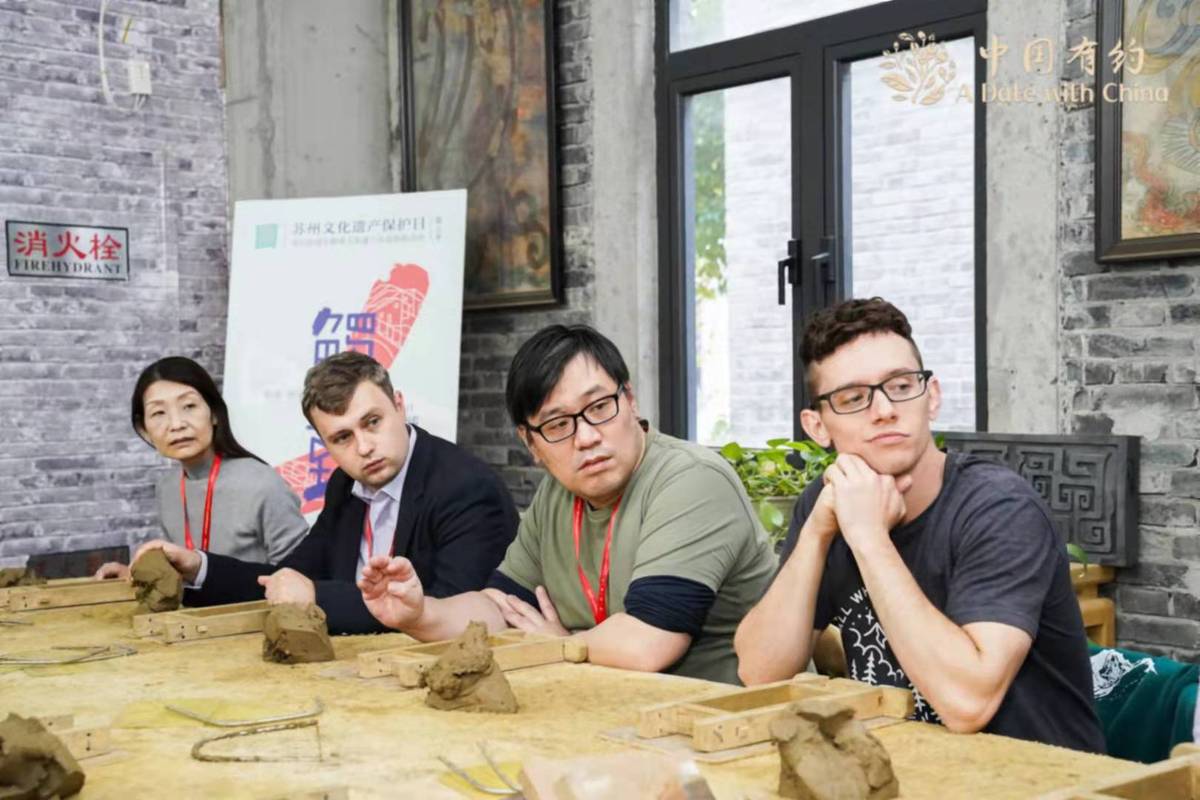
??Andrew Chin, second from right, learns how to make a brick at the Suzhou Museum of Imperial Kiln on Oct 25. [Photo/chinadaily.com.cn]
??Suzhou's beauty has been renowned for centuries. The legendary Italian explorer Marco Polo dubbed it the "Venice of the East" in his 13th century travel logs, and a Chinese proverb states that, "up in heaven, there is paradise; down below, there is Hangzhou and Suzhou."
??The city's efforts to preserve its historic beauty were evident throughout the numerous sites I visited during the Suzhou stop of the "A Date With China" international media tour.
??Its contributions to the construction of a cultural belt of the Grand Canal have been enormous. This was an initiative proposed by the central government in 2019 to preserve the cultural heritage of the world's longest man-made waterway, which runs nearly 3,200 kilometers through 18 cities from Beijing to Hangzhou and is over 2,500 years old. Commitment to that mission is evident in the area's clean environment, tranquil atmosphere and well-preserved architecture.
??Walking along Pingjiang Road in Suzhou's Old Town, tea houses and local handicraft stores mix with big brands like Starbucks housed in traditional Song Dynasty buildings, creating a lively scene that has made the area a vibrant part of Suzhou for eight centuries.
??However, the transformation of three neglected small lanes off Pingjiang Road into the Dongshengli Cultural and Art Corridor shows the city's desire for innovation. A mixture of small art galleries, coffee shops and colorful graffiti has made it a popular destination to take selfies, becoming an internet hotspot that appeals to young visitors.
??Local traditional arts live on in the Master of the Nets Garden, a UNESCO World Heritage Site and arguably the most well-preserved of Suzhou's Classical Gardens. First laid out in 1140 by Shi Zhengzhi, an official in the Southern Song Dynasty (1127-1279), it comes alive at night with live performances of Kunqu Opera, pingtanballads, shadow dancing, and traditional Chinese instrumental music.
??Suzhou's history of innovation is celebrated at the Suzhou Museum of Imperial Kiln Brick. The 4A-rated tourism attraction details the manufacturing process to create Jin Zhuan or "golden bricks", which were used to build imperial palaces since the Ming (1368-1644) and Qing (1644-1911) dynasties, including the Palace Museum in Beijing.
??Remnants of the historic Lumu Imperial Kiln sit outside the museum, while a nearby workshop allows visitors to get their hands dirty creating a brick by utilizing some of the techniques that were named a provincial intangible cultural heritage in 2006.
??Even with its long history and rich culture, Suzhou continues to look toward the future. At Suzhou High-Speed Railway New Town, I ride a driverless minibus developed by QCraft, China's first robo-bus to operate on public roads.
??Equipped with GPS, four cameras, two laser sensors and five radar sensors, the driverless minibus is able to detect obstacles on the road, and riders can see what the sensors are monitoring in real time on the large screen displayed at the front of the bus.
??Although the driverless bus is still in trial operation, the company is eyeing a future in this burgeoning field, where automated taxis and buses can transport large amounts of people from high-density areas like train stations and airports.
??Suzhou's mixture of historic culture and modern innovation is evident at the Yao Silk Art and Life Space in Suzhou's trendy Ligongdi area. Founded by Yao Lan, daughter of the "Queen of Su embroidery" Yao Jianping, the company has become renowned for integrating the intangible cultural heritage of Su embroidery into modern products like watches and jewelry.
??Honoring ancient traditions while integrating them into a modern framework is the defining characteristic of Suzhou. It's a historically renowned city with an even brighter future.